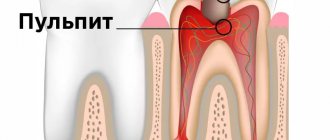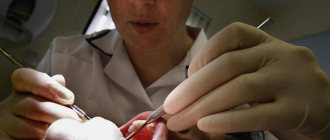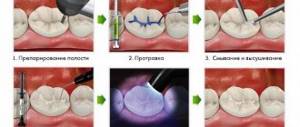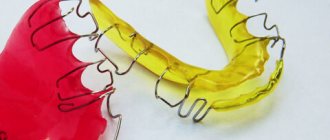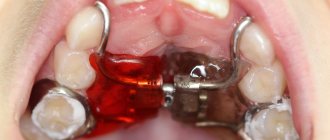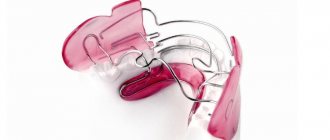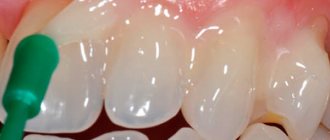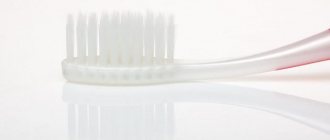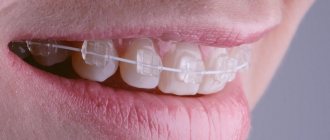Jaw expansion is a process of correction of jaw tissue, which is necessary in case of crowding of teeth, narrowing of the jaw arch, if the jaw is narrow, teeth are placed unevenly, etc. All these anomalies noticeably spoil the aesthetics of appearance, but, fortunately, modern orthodontic techniques can effectively solve the problem .
The bone expansion procedure is recommended for the following diagnoses:
- micrognathia (underdevelopment of the jaw);
- microgenia (underdevelopment of the lower jaw);
- incisor protrusion (a pathology in which the front teeth are tilted too forward);
- mesial occlusion (impaired closure of tooth rows);
- cross bite or crossing of the jaws;
- narrowing of the apical base and reduction in the perimeter of the jaw arch.
Design and principle of operation
The Derichsweiler apparatus consists of elements :
- plate made of plastic or metal;
- metal screw;
- hooks, wire arches.
This design is located at the top of the palate, cast arches are attached to the side teeth, exerting pressure on them . The plate inside is equipped with a screw and metal fittings - hooks, which are fixed on the supporting molars.
Having securely fastened the device, the doctor looks at the effect it has on the teeth.
In addition to jaw expansion, there is also the movement of certain teeth that need correction.
During the treatment process, the design undergoes changes - a metal screw is tightened, which increases the area of the plate and increases the pressure.
The screw allows you to apply a gradually increasing load on the teeth, thereby fixing their displacement.
In addition to the problem of a narrow jaw, another, accompanying problem is solved - gaps between the teeth. As a result of pressure on the molars, incisors and premolars, these gaps are eliminated using springs and screws.
Devices for jaw expansion
A narrowed jaw is a common phenomenon, so scientists and doctors have developed devices that help correct the pathology without surgery. Most often, the use of structures has a positive effect.
The devices act gently and gradually, causing minimal discomfort to the patient, which is why they are often used in the treatment of children. Under slight constant pressure, bone tissue is deformed, causing teeth to move slowly. In this way, it is possible to achieve lengthening of the dental arch. Currently, there are several designs designed to expand the upper and lower jaw.
Derichsweiler orthodontic appliance
If there is not enough space on the dental arch and braces cannot guarantee the desired effect, turn to the Derichsweiler apparatus. It is an arc with rings at the ends. The rings are placed on the teeth, and this action secures the device. There is a screw in the center of the arch that is activated to apply pressure to the bone.
Advantages of the Derichsweyer apparatus:
- gradual smooth correction of the bite;
- the child cannot remove the device independently;
- the device does not harm the soft tissues of the oral area;
- The roots of the teeth do not move, but remain in their sockets.
Disadvantages of the Derichsweyer apparatus:
- increased salivation during the first time after installation;
- possible tongue injuries;
- complicated oral hygiene;
- inability to independently activate or adjust, which will require frequent visits to the dentist;
- high cost due to individual design for the patient.
Palatal expander
This is a complicated version of the Derichsweier apparatus. From the central sliding part there are 4 arches with rings that are attached to the back molars. The design has proven to be very effective in treating children: a child’s jaw enlarges in about three weeks. Adults will need more time, up to one and a half years.
Pros of a palatal expander:
- speed of formation of the correct bite;
- painlessness;
- possibility of self-activation.
Cons of a palatal expander:
- tongue injury;
- complicated oral hygiene.
Plate
This is a removable structure, which is a product consisting of plastic plates, stainless steel springs and an orthodontic screw in the center; fastening occurs due to vestibular arches and clasps. Fixed options can be fixed with crowns attached to the back molars. This device is most often used among children from 5 to 12 years old, as it is most effective during the period of active bone growth. It is made individually, so it can be used for uneven narrowing of the dentition.
- painlessness;
- can be removed for hygiene procedures;
- When using the plate, not only the expansion of the jaw is achieved, but also the alignment of the front teeth.
Disadvantages of an expansion plate:
- discomfort that may arise due to the bulk of the structure;
- Suitable only for children.
Systems required for mandibular distraction
If there are problems with the lower jaw, completely different devices are usually installed - distractors. In this case, adult patients need to dissect the lower jaw with an ultrasonic scalpel before installing the structure.
There are different types of distractors. This variety allows you to choose a design even for infants, because pathologies of the lower jaw are most often congenital, and they need to be corrected as early as possible.
The distractor is based on a flat body on which a self-locking screw and slider are located. This system is complemented by levers with wedge-shaped ends for fixation in the tissues of the alveolar ridge.
- https://zubovv.ru/lechenie/chelyust/malenkaya-nizhnyaya.html
- https://zub.clinic/brekety/mikrogeniya
- https://www.KrasotaiMedicina.ru/diseases/zabolevanija_stomatology/micrognathia
- https://rebenkoved.ru/zdorove/lechenie/lechenie-nedorazvitiya-nizhnej-chelyusti-u-rebenka.html
- https://www.ortholike.ru/articles/ukhod-za-zubami/pochemu-u-rebenka-uzkaya-chelyust/
- https://stoma-tolog.com/patoloii/diagnostika/mikrognatiya.html
- https://AzbukaZubov.com/stomatolog/okklyuziya/uzkaya-chelyust-chto-delat.html
- https://imdent.ru/bolshie-zuby-malenkaya-chelyust/
Ekaterina Belikova
Dentist-therapist. Periodontist. Doctor of the highest category. High class specialist. Specializes in the treatment of carious and non-carious dental lesions.
Indications for use
The Derichsweiler apparatus is necessary for patients who have the following problems :
- the upper jaw is too narrow, this is determined by the relationship between the upper and lower teeth, sometimes a person experiences difficulty chewing food, speaking and aesthetic discomfort;
- with crowding of molars, premolars in the upper jaw;
- in the presence of crossbite;
- if the fangs on the upper jaw grow incorrectly, out of place.
If these problems exist, dentists choose this particular device, as it allows you to effectively straighten your teeth in a short period of time .
Facebow
Used in adolescence in growing patients up to 12-13 years of age. The use of this device is effective in cases of predominant growth of the upper jaw and the goal of treatment on the face bow is to move the teeth in the upper jaw posteriorly.
Indications for use:
1. Distal bite. 2. Early loss of chewing milk teeth and displacement of the permanent 6 teeth. 3. To inhibit the growth of the upper jaw.
Wearing mode:
The orthodontist always recommends wearing it 24 hours a day. But in reality we're hoping for night, evening and weekend wear. Those. The face bow must be in the mouth for more than 12 hours a day.
Wearing period:
Most often, a facebow is prescribed together with a brace system (partial 4*2) or full. And it is used until the target is achieved (6-18 months).
Contraindications
The Derichsweiler apparatus is used up to the age of 20-23 years.
Its use is indicated for everyone who has the problems listed above. The only contraindication is an allergic reaction to metal or plastic that is part of the device.
It is not recommended to actively use it in case of cleft of the soft and hard palate, since with this defect an operation is performed to tighten the palatal suture, and the device just widens this suture.
In such a case, the treating orthodontist makes his verdict. After all, with this defect there are a lot of concomitant pathologies of tooth growth.
Devices for jaw expansion
A narrowed jaw is a common phenomenon, so scientists and doctors have developed devices that help correct the pathology without surgery. Most often, the use of structures has a positive effect.
The devices act gently and gradually, causing minimal discomfort to the patient, which is why they are often used in the treatment of children. Under slight constant pressure, bone tissue is deformed, causing teeth to move slowly.
READ ALSO: structure of the upper and lower jaws with photos and descriptions
Derichsweiler orthodontic appliance
If there is not enough space on the dental arch and braces cannot guarantee the desired effect, turn to the Derichsweiler apparatus. It is an arc with rings at the ends. The rings are placed on the teeth, and this action secures the device. There is a screw in the center of the arch that is activated to apply pressure to the bone.
Due to this design, the palatal suture opens, expanding the jaw. The gap that appears is filled with newly formed bone tissue. For a child, the Derichsweiler design is one of the best devices that allows you to painlessly enlarge the jaw. Adults need to “loosen” the palatal suture in advance through surgery.
Advantages of the Derichsweyer apparatus:
- gradual smooth correction of the bite;
- the child cannot remove the device independently;
- the device does not harm the soft tissues of the oral area;
- The roots of the teeth do not move, but remain in their sockets.
Disadvantages of the Derichsweyer apparatus:
- increased salivation during the first time after installation;
- possible tongue injuries;
- complicated oral hygiene;
- inability to independently activate or adjust, which will require frequent visits to the dentist;
- high cost due to individual design for the patient.
Palatal expander
This is a complicated version of the Derichsweier apparatus. From the central sliding part there are 4 arches with rings that are attached to the back molars. The design has proven to be very effective in treating children: a child’s jaw enlarges in about three weeks. Adults will need more time, up to one and a half years.
As the name suggests, a palatal expander can only expand the upper jaw. To expand the lower jaw, you will have to select a different design. Sometimes this device is confused with a palatal clasp, which has a completely different function: it serves to fix molars during bite correction. Often it plays the role of an auxiliary structure, for example, used with braces.
Pros of a palatal expander:
- speed of formation of the correct bite;
- painlessness;
- possibility of self-activation.
INTERESTING: the differences between a correct bite and an incorrect bite
Cons of a palatal expander:
- tongue injury;
- complicated oral hygiene.
Plate
This is a removable structure, which is a product consisting of plastic plates, stainless steel springs and an orthodontic screw in the center; fastening occurs due to vestibular arches and clasps. Fixed options can be fixed with crowns attached to the back molars. This device is most often used among children from 5 to 12 years old, as it is most effective during the period of active bone growth. It is made individually, so it can be used for uneven narrowing of the dentition.
Pros of the expansion plate:
- painlessness;
- can be removed for hygiene procedures;
- When using the plate, not only the expansion of the jaw is achieved, but also the alignment of the front teeth.
Disadvantages of an expansion plate:
- discomfort that may arise due to the bulk of the structure;
- Suitable only for children.
Systems required for mandibular distraction
If there are problems with the lower jaw, completely different devices are usually installed - distractors. In this case, adult patients need to dissect the lower jaw with an ultrasonic scalpel before installing the structure.
There are different types of distractors. This variety allows you to choose a design even for infants, because pathologies of the lower jaw are most often congenital, and they need to be corrected as early as possible.
The distractor is based on a flat body on which a self-locking screw and slider are located. This system is complemented by levers with wedge-shaped ends for fixation in the tissues of the alveolar ridge.
Advantages and disadvantages
In orthodontics, there are several methods for treating narrowness of the upper jaw.
But the Darichsweiler design has several advantages over them:
- the patient gets quick results, after a short treatment there is a noticeable expansion of the upper jaw;
- a person quickly gets used to the device, even if at first he experiences discomfort when wearing it;
- This device is used along with other methods of teeth straightening, for example, braces.
Using this mechanism, a person gets quick and high-quality results.
But when using it, patients sometimes experience complications. They are the disadvantage of this device.
When used in childhood, the child's palate may open. If you start treatment before the molars grow, you can avoid negative consequences.
This is due to the fact that in early childhood the palatine lobes have not yet completely fused, which allows for a good result to be achieved.
Face-Mask
The facial mask ( Dilyara ) belongs to the category of auxiliary extraoral orthodontic appliances that are used to treat mesial occlusion in childhood and early mixed dentition.
There are several most common types of face masks used to correct malocclusion: Dilyar's mask, Tubinger's mask, Petit's mask. All face masks differ only in design features, they relate to the size, type and points of attachment of the mask on the face, but have the same purpose - to correct the bite. Their action is based on the formation of extraoral horizontal and mesial traction, which affects the growth of the upper jaw, thereby “stretching” the jaw.
A face mask is prescribed in the following cases:
1. The profile of the face should be concave (protruding chin, receding upper lip) 2. Early age, since the most effective use of the mask is in the primary and early mixed dentition;
The face mask is a metal frame containing two supports that are placed on the patient's chin and forehead and are combined with elastic traction. The face mask is used in combination with a plate and hooks for traction, or a brace system.
Benefits of face masks
1. Easily removable outer part of the mask. 2. Easy to remove the thread after use. 3. Easy care of the device (the lightness and elegance of the entire structure, which allows you to feel the mask on your face no worse than glasses on your nose, the support pads do not cause irritation and allergic reactions). 4. High efficiency of the entire structure.
Disadvantages of the device
The only significant drawback of extraoral appliances is the impossibility of their round-the-clock use. The effectiveness of treatment depends on compliance with wearing a mask. On average, treatment using a face mask takes 2-4 months when wearing it 12-16 hours a day.
Manufacturing process
To manufacture the device, you need to perform some manipulations with a doctor.
- At the first consultation, the specialist takes an impression of the teeth, which must be done very carefully, because the effectiveness of the treatment and the duration of the patient’s adaptation depend on this.
- First, the deepest part of the palate and torus is isolated, for which the doctor makes a gasket, no more than 4.5 mm in thickness.
- The interdental papillae of the gums and the front part of the palate are relieved of pressure.
- The plate itself is made of transparent plastic, which greatly facilitates the process of correction and monitoring the state of the sky under the plate.
- After fitting the device to the patient, the device is checked on a plaster model of the jaw, and the ability of the screw to work is assessed.
We will tell you how the Brückl-Reichenbach apparatus works in a separate article.
In this publication we will compare the appearance of diastemas before and after therapy.
Here https://orto-info.ru/sistemyi-vyiravnivaniya-zubov/breketyi/po-raspolozheniyu/vestibulyarnyie/victory.html you will find a review and photo of Victory braces.
Operating principle
The operation of the Nord system is based on the creation of an expanding force by the Hyrax screw and its transmission to the palatal surface of the chewing teeth through rings and acrylic plates. Under its action, the palatine bone expands along the line of the median suture.
It ruptures if it has already fused, or expansion occurs without rupture if obliteration of the suture has not yet occurred. The device is activated by turning a screw with a special key by the patient himself or another person.
There are fast and slow expansion technologies. With fast, the screw is tightened once or twice a day by ½ or ¾ of a turn, which is 0.2-0.5 mm. With slow expansion, the screw is activated once every 3 days. The most commonly used is rapid expansion.
The active phase of treatment is followed by a retention period, ensuring the absence of relapse and the fusion of the palate bones in the new position.
The essence of the use of the Alf system in orthodontics and the effectiveness of the device.
In this publication we will talk about the purpose and types of bionators.
Here we will consider the technique of using the Persin apparatus to correct mesial occlusion.
Installation sequence
The accuracy of installation of the mechanism is important for the patient, because he will feel a foreign body in the oral cavity for at least another 3 months.
Treatment takes place in several stages:
- After checking the screw mechanism and adjusting the plate on the plaster jaw, the device is installed on the patient . The patient is given a day to master the device. At this time, he learns to use it and gets used to it.
- Then the patient, if nothing bothers him, has crowns and rings attached to his molars using special dental cement.
- 24 hours after fastening, the doctor begins the treatment process: the screw is unscrewed .
- Every day the screw is activated half a turn, the doctor and the patient monitor the condition of the device in the oral cavity and general well-being.
If the pain after turning the screw disappears within a minute, then you can continue treatment.
It is important not to overtighten the screw - this can lead to complications. If you add a little pressure, you may experience pain in the temples and bridge of the nose. In this case, the doctor returns the screw a little back.
After just a week, you can see the first result of the device - a diastema appears between the front teeth - a gap that grows and then goes away. There is a gradual alignment of the teeth.
Upon completion of treatment:
- the side teeth fall into place,
- the sky slightly increases its area,
- the lower part of the face visually becomes larger,
- the lower jaw falls into place,
- teeth align their position.
At what stage of bite correction is the Derichsweiler apparatus used, look at the video:
When the process of tightening the screw is completed, it is covered with a plastic plate for the patient’s convenience and to minimize discomfort.
Derichsweiler apparatus manufacturing and installation
Step-by-step production and installation of the device:
- Before manufacturing and installing the drug, the doctor will need to slightly move the supporting teeth apart. To do this, special separation rings - rubber rings - are installed between the dental units. This procedure will take 5–10 minutes. The teeth will begin to shift, and the patient will initially feel aching pain. While wearing the rings, you should not eat astringent foods or chewing gum. If the rubber band falls out, you can install it yourself. To do this, you can use regular threads. Carefully install the elastic, stretching its edges.
- At the second stage, the doctor removes the rubber rings and creates an impression for the future design. After this, the rings are placed in their places. The period during which the system is being manufactured can be devoted to thorough teeth cleaning. The resulting gaps will just help you get to hard-to-reach places.
- After the design is made, it is tried on. If everything fits perfectly, the device is installed and fixed. The first tightening of the screw is performed by the doctor himself, selecting the optimal force of the structure on the jaw. Then the tightening procedure will be carried out by the patient himself. To do this, the doctor creates a specific schedule that must be adhered to. It is different for each patient. If we talk about average indicators, at first the procedure is repeated once every 3 days, then daily.
You can see the first results within 2–3 weeks. Do not forget that the gap formed at the suture site is filled with new bone mass; additional time is needed. The average period of wearing the device is six months.
How long to wear?
During the consultation, the orthodontist determines the approximate timing depending on the degree of anomaly in the position of the teeth.
The process of tightening the screw can last from a week to 2-3 months. It also depends on the age of the patient and the process of adaptation to the device. If any complications arise during treatment, more time will be required for alignment.
After tightening the screw, a period of retention follows - maintaining the achieved result . This is a very important time, because if it is not organized correctly, all efforts come to nothing.
The device stays in the oral cavity for a total of 2-3 months.
Early treatment: orthodontic plates and trainers.
A plate with a screw for the lower jaw.
Elastic positioners: trainers, LM-activators, Myobrace and other functional devices are designed to activate jaw growth and eliminate bad habits. In addition, some types of trainers, for example, the Myobrace brand, have cells for teeth (helps teeth erupt correctly, in case of not very pronounced anomalies). Since elastopositioners are double-jawed devices, they cannot be worn around the clock. The wearing scheme is as follows: mandatory evening wear for 2-3 hours (for example, while watching cartoons, etc.) + mandatory night wear.
The functional group includes the Frenkl apparatus and its modification: the Persin apparatus. Perhaps one of the most famous “name” devices. There are 3 main types to correct different anomalies. The principle of operation is similar to elastopositioners: changing muscle balance and stimulating the growth of the upper or lower jaw. The wearing pattern is similar and the effectiveness is comparable to trainers. The difference is that the Frenkl apparatus and its modifications are made of hard plastic and are much less comfortable to wear. In addition, it requires a high level of skill from the technician and physician to properly manufacture and fit it in the oral cavity. Today, elastopositioners are preferable to use precisely for these reasons.
Double-jaw devices to activate the growth and advancement of the lower jaw. This group includes a twin-block device and a Twicare device. Used for distal occlusion (Class 2 according to Angle). They can be used in adults: in this case, the lower jaw does not grow, but only moves to a more anterior position. But in some cases, this is what is needed, since the posterior position of the lower jaw is a fairly common phenomenon.
Twin block device diagram.
Device for rapid palatal expansion. It has many names: expander, Derichsweiler apparatus and others. There are many modifications, but the essence and active part (screw) is the same. Used to correct narrowing of the upper jaw. It is a non-removable device. Can also be used in adults, but only in combination with surgical support. It has a screw similar to the screw of conventional plates for expanding the upper jaw, only more powerful, as well as a more durable design. The screw is tightened much more often, and accordingly, expansion occurs quickly (due to the divergence of the median palatal suture) - in children it is quite mobile, and in adults it is mobilized surgically. Often, to reduce the lateral inclination of teeth, support is used on microimplants installed in the palate. There are many opinions at what age the use of a palatal expander is justified: most orthodontists believe that the optimal age is 13-14 years, but sometimes the device is placed on six-year-old children based on milk teeth and good results are achieved.
There are a great variety of different nominal devices, differing in both design and principle of operation. Many of them have long been outdated, many are quite functional, but have more convenient/effective/easy-to-use analogues, some are still relevant today. The main thing is that your orthodontist clearly understands why he is prescribing this or that device.
Quadhelix is a device for expanding the palate.
Possible complications
Complications during treatment with the Derichsweiler apparatus include dehiscence of the palate suture . This occurs due to weak tissues or too much pressure on the teeth. Sometimes it is difficult to adjust the position of the screw correctly.
The occurrence of persistent pain is also a complication of treatment with this device.
Features of treatment
Usually a narrowed jaw is combined with other dental anomalies and disorders - excessive development of the lower jaw, mouth breathing, pronunciation defects. Therefore, treatment with a Ross device can be especially effective in complex treatment.
In particular, in addition to the device it is desirable:
- the use of a face mask - an extra-oral structure, which, thanks to the chin pad, stops the development of the lower jaw;
- with mouth breathing, it is advisable to participate in the treatment of an ENT doctor. He must monitor the process of normalization of breathing;
- Correction of speech and swallowing is recommended with the participation of a speech therapist and myofunctional therapist. Their task is to normalize the tone of the facial and chewing muscles, correct the pressure of the tongue on the teeth, and control swallowing.
Only with such joint efforts can we ensure correction of all the adverse consequences of a narrowed jaw.
Care instructions
Since the device is not removable, but is constantly in the oral cavity, it must be carefully looked after. Food debris accumulates between the wire and the teeth, forming plaque, which must be carefully cleaned with a medium-hard brush .
The patient periodically needs to visit the dentist or hygienist to clean all the hard-to-reach areas between the appliance and the teeth. The patient receives cleaning instructions each time a screw is tightened.
It is imperative to comply with the requirements for oral care, especially if other orthodontic systems are used together with the device.
In this case, it is better to rinse your mouth after each meal and not to eat hard, hard foods .
Reasons for the development of micrognathia
Anomalies of jaw development can be congenital or acquired.
Congenital ones include:
- Severe acute illnesses of a woman during pregnancy,
- Anomalies of intrauterine development of the fetus,
- Congenital pathologies of the development of the dental system,
- Genetic predisposition.
An acquired anomaly can result from:
- Maxillofacial trauma,
- Artificial feeding and improper sucking in infancy,
- Diseases of the endocrine system,
- Past infectious diseases and inflammatory processes,
- Early loss of baby teeth,
- Problems with nasal breathing.
What is the price?
All individual designs have a fairly high price, because they are not produced on a conveyor belt, which means that their production takes more time and effort. The price for each patient depends on several criteria :
- material for making plates, crowns and rings;
- region of residence of the patient;
- prices for doctor's services, which are determined for each medical institution.
After the inspection, the specialist can tell you the approximate price for the device.
The device itself can be purchased at a price of 8,500 rubles .
But the total cost will also include consultation with a specialist, manufacturing of the mechanism and its installation. In addition, the patient comes to tighten the screw, which is also paid for.
How does crossbite manifest in children and what are the differences in the methods of influencing it?
In this article, we will discuss how much teeth straightening trays cost and what factors influence the price.
At the link https://orto-info.ru/zubocheliustnye-anomalii/okklyuzii/glubokiy-prikus.html we published a selection of photos of how the face changes with a deep bite.
Advantages and disadvantages
The advantages of using such a device include:
- the result is noticeable within two weeks;
- treatment time is shortened, the course usually takes about two months;
- no surgical intervention required;
- the correction is smooth, gradual, the effect is stable;
- adaptation to the product is fast;
- the design can be combined with others, for example, braces.
The disadvantages include age restrictions, the risk of rubbing the tongue on metal parts at first. In addition, the device will be effective only if installed during the period of jaw formation; effectiveness decreases after 18 years. After 23, this method of treatment is not used.
Installation sequence
To fix the structure, the following steps are used:
- inspection and diagnostics, selection of materials for manufacturing the structure;
- the supporting teeth are moved apart using separation rubber rings (at this stage the Patient feels slight discomfort and aching pain);
- at the second stage, the rings are removed, the dentist makes impressions for the manufacture of the device;
- After fitting, the structure is installed and the patient receives instructions on how to move the screws.
There are no particular complications during treatment, but slight discomfort may occur. It is important to follow a diet that excludes solid foods.
Price
The price of the Derichsweiler apparatus averages 8,500 rubles per design. The exact cost is influenced by the following factors:
- manufacturing materials;
- condition of the oral cavity;
- the need for preliminary treatment;
- complexity of the pathology, installation features.
About Us
My Ort Dentistry Clinic offers orthodontic services for children. We provide the following benefits:
- modern, fully equipped offices;
- comfortable conditions and attention to each Patient;
- qualified doctors;
- complex therapy, including diagnosis, treatment and prevention;
- favorable prices for therapeutic services.
We are waiting for you at the address: St. Petersburg, st. Yesenina, 1, building 1. We work seven days a week, you can make an appointment using a convenient form on the website or by phone.
